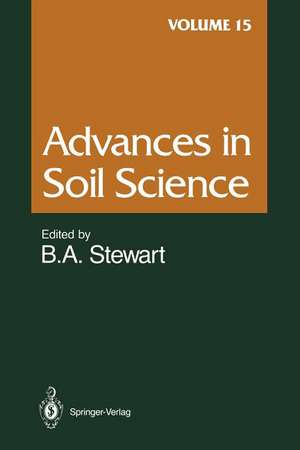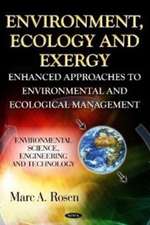Advances in Soil Science: Volume 15: Advances in Soil Science, cartea 15
Contribuţii de J.M. Barea, J.A.A. Berkhout, A. Bronger, R. Lal, J.F. Power, R. Prasad, C.A. van Diepen, H. van Keulen, J. Wolfen Limba Engleză Paperback – 16 sep 2011
Din seria Advances in Soil Science
-
 Preț: 444.08 lei
Preț: 444.08 lei -
 Preț: 448.67 lei
Preț: 448.67 lei - 25%
 Preț: 427.84 lei
Preț: 427.84 lei - 15%
 Preț: 467.93 lei
Preț: 467.93 lei - 18%
 Preț: 1954.45 lei
Preț: 1954.45 lei - 12%
 Preț: 312.43 lei
Preț: 312.43 lei -
 Preț: 374.21 lei
Preț: 374.21 lei - 25%
 Preț: 941.40 lei
Preț: 941.40 lei -
 Preț: 448.44 lei
Preț: 448.44 lei - 18%
 Preț: 1289.11 lei
Preț: 1289.11 lei - 15%
 Preț: 473.34 lei
Preț: 473.34 lei - 18%
 Preț: 1304.13 lei
Preț: 1304.13 lei - 22%
 Preț: 464.32 lei
Preț: 464.32 lei - 18%
 Preț: 1300.62 lei
Preț: 1300.62 lei - 18%
 Preț: 1941.67 lei
Preț: 1941.67 lei - 18%
 Preț: 1284.86 lei
Preț: 1284.86 lei - 15%
 Preț: 461.03 lei
Preț: 461.03 lei - 18%
 Preț: 1290.23 lei
Preț: 1290.23 lei - 18%
 Preț: 1119.62 lei
Preț: 1119.62 lei - 18%
 Preț: 1290.71 lei
Preț: 1290.71 lei - 18%
 Preț: 1233.70 lei
Preț: 1233.70 lei - 15%
 Preț: 641.38 lei
Preț: 641.38 lei - 15%
 Preț: 636.63 lei
Preț: 636.63 lei - 15%
 Preț: 643.84 lei
Preț: 643.84 lei - 15%
 Preț: 637.46 lei
Preț: 637.46 lei - 15%
 Preț: 701.59 lei
Preț: 701.59 lei - 15%
 Preț: 636.30 lei
Preț: 636.30 lei - 15%
 Preț: 638.43 lei
Preț: 638.43 lei - 15%
 Preț: 648.89 lei
Preț: 648.89 lei - 15%
 Preț: 641.71 lei
Preț: 641.71 lei - 15%
 Preț: 637.59 lei
Preț: 637.59 lei -
 Preț: 385.47 lei
Preț: 385.47 lei - 15%
 Preț: 641.85 lei
Preț: 641.85 lei - 15%
 Preț: 637.28 lei
Preț: 637.28 lei - 15%
 Preț: 637.59 lei
Preț: 637.59 lei - 15%
 Preț: 638.57 lei
Preț: 638.57 lei - 15%
 Preț: 637.46 lei
Preț: 637.46 lei - 15%
 Preț: 637.93 lei
Preț: 637.93 lei -
 Preț: 384.70 lei
Preț: 384.70 lei - 15%
 Preț: 637.28 lei
Preț: 637.28 lei - 28%
 Preț: 1414.85 lei
Preț: 1414.85 lei
Preț: 639.59 lei
Preț vechi: 752.45 lei
-15% Nou
Puncte Express: 959
Preț estimativ în valută:
122.40€ • 132.91$ • 102.82£
122.40€ • 132.91$ • 102.82£
Carte tipărită la comandă
Livrare economică 22 aprilie-06 mai
Preluare comenzi: 021 569.72.76
Specificații
ISBN-13: 9781461277682
ISBN-10: 146127768X
Pagini: 280
Ilustrații: IX, 262 p.
Dimensiuni: 155 x 235 x 15 mm
Greutate: 0.4 kg
Ediția:Softcover reprint of the original 1st ed. 1991
Editura: Springer
Colecția Springer
Seria Advances in Soil Science
Locul publicării:New York, NY, United States
ISBN-10: 146127768X
Pagini: 280
Ilustrații: IX, 262 p.
Dimensiuni: 155 x 235 x 15 mm
Greutate: 0.4 kg
Ediția:Softcover reprint of the original 1st ed. 1991
Editura: Springer
Colecția Springer
Seria Advances in Soil Science
Locul publicării:New York, NY, United States
Public țintă
ResearchCuprins
Vesicular-Arbuscular Mycorrhizae as Modifiers of Soil Fertility.- I. Introduction.- II. Mycorrhizae.- III. Development of Vesicular-Arbuscular Mycorrhizae.- IV. Root-Soil Interactions.- V. Vesicular-Arbuscular Mycorrhizae and Acquisition of Phospate by Plants.- VI. Vesicular-Arbuscular Mycorrhizae and Nitrogen Nutrition.- VII. Vesicular-Arbuscular Mycorrhizae and the Acquisition of Other Nutrients.- VIII. Vesicular-Arbuscular Mycorrhizae and Plant Growth under Stress Situations.- IX. Managing Vesicular-Arbuscular Mycorrhizae under Natural Conditions.- X. Conclusions.- References.- Argillic Horizons in Modern Loess Soils in an Ustic Soil Moisture Regime: Comparative Studies in Forest-Steppe and Steppe Areas from Eastern Europe and the United States.- I. Introduction.- II. Geographic Comparison of the Forest-Steppe and Steppe Regions of Eastern Europe and the United States.- III. Results.- IV. Discussion.- V. Summary and Conclusions.- Acknowledgments.- References.- Myths and Scientific Realities of Agroforestry as a Strategy for Sustainable Management for Soils in the Tropics.- I. Introduction.- II. Farming Systems Prevalent in the Tropical Rainforest Zone.- III. Need for Introducing Permanently Sustainable Farming Systems.- IV. Alley Cropping.- V. Transfer of Alley-Cropping Technologies.- VI. Research Priorities.- VII. Modus Operandi.- VIII. Linking Training with Research.- IX. Potential of Agroforestry: Myth or Reality.- References.- Land Evaluation: From Intuition to Quantification.- I. Introduction.- II. Historical Perspective.- III. Major Systems and Trends since 1950.- IV. The FAO Framework as a Standard in Land Evaluation.- V. Land Evaluation in Practice: Selected Case Studies.- VI. Yield Estimates and Productivity Ratings.- VII. Use of Models in Regional Land Evaluations.- VIII. Application of Land Evaluation in Land Use Planning.- IX. Conclusions.- References.- Crop Residue Management.- I. Introduction.- II. Grain Yield.- III. Soil Chemical Properties.- IV. Soil Physical Properties.- V. Soil Biological Properties.- VI. Fertilizer Needs of Crops.- VII. Environment.- VIII. Summary and Conclusions.- Acknowledgments.- References.














